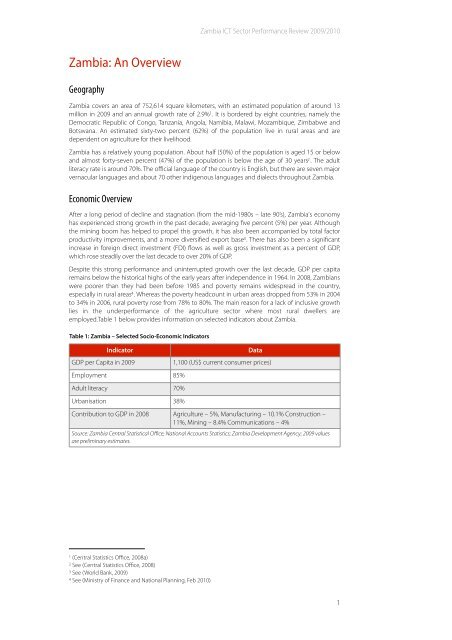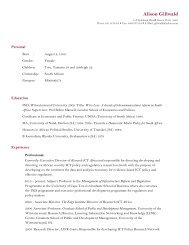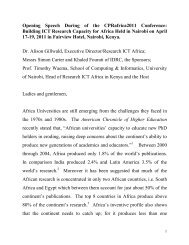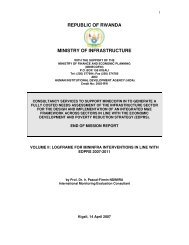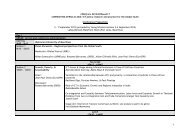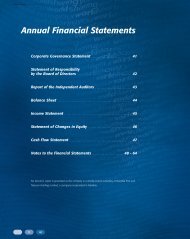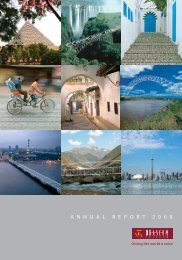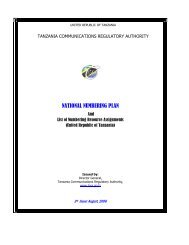Zambia ICT Sector Performance Review 2010 - Research ICT Africa
Zambia ICT Sector Performance Review 2010 - Research ICT Africa
Zambia ICT Sector Performance Review 2010 - Research ICT Africa
You also want an ePaper? Increase the reach of your titles
YUMPU automatically turns print PDFs into web optimized ePapers that Google loves.
<strong>Zambia</strong> <strong>ICT</strong> <strong>Sector</strong> <strong>Performance</strong> <strong>Review</strong> 2009/<strong>2010</strong><br />
<strong>Zambia</strong>: An Overview<br />
Geography<br />
<strong>Zambia</strong> covers an area of 752,614 square kilometers, with an estimated population of around 13<br />
million in 2009 and an annual growth rate of 2.9% 1 . It is bordered by eight countries, namely the<br />
Democratic Republic of Congo, Tanzania, Angola, Namibia, Malawi, Mozambique, Zimbabwe and<br />
Botswana. An estimated sixty-two percent (62%) of the population live in rural areas and are<br />
dependent on agriculture for their livelihood.<br />
<strong>Zambia</strong> has a relatively young population. About half (50%) of the population is aged 15 or below<br />
and almost forty-seven percent (47%) of the population is below the age of 30 years 2 . The adult<br />
literacy rate is around 70%. The official language of the country is English, but there are seven major<br />
vernacular languages and about 70 other indigenous languages and dialects throughout <strong>Zambia</strong>.<br />
Economic Overview<br />
After a long period of decline and stagnation (from the mid-1980s – late 90’s), <strong>Zambia</strong>'s economy<br />
has experienced strong growth in the past decade, averaging five percent (5%) per year. Although<br />
the mining boom has helped to propel this growth, it has also been accompanied by total factor<br />
productivity improvements, and a more diversified export base 3 . There has also been a significant<br />
increase in foreign direct investment (FDI) flows as well as gross investment as a percent of GDP,<br />
which rose steadily over the last decade to over 20% of GDP.<br />
Despite this strong performance and uninterrupted growth over the last decade, GDP per capita<br />
remains below the historical highs of the early years after independence in 1964. In 2008, <strong>Zambia</strong>ns<br />
were poorer than they had been before 1985 and poverty remains widespread in the country,<br />
especially in rural areas 4 . Whereas the poverty headcount in urban areas dropped from 53% in 2004<br />
to 34% in 2006, rural poverty rose from 78% to 80%. The main reason for a lack of inclusive growth<br />
lies in the underperformance of the agriculture sector where most rural dwellers are<br />
employed.Table 1 below provides information on selected indicators about <strong>Zambia</strong>.<br />
Table 1: <strong>Zambia</strong> – Selected Socio-Economic Indicators<br />
Indicator<br />
GDP per Capita in 2009<br />
Employment 85%<br />
Adult literacy 70%<br />
Urbanisation 38%<br />
Data<br />
1,100 (US$ current consumer prices)<br />
Contribution to GDP in 2008 Agriculture – 5%, Manufacturing – 10.1% Construction –<br />
11%, Mining – 8.4% Communications – 4%<br />
Source: <strong>Zambia</strong> Central Statistical Office, National Accounts Statistics; <strong>Zambia</strong> Development Agency; 2009 values<br />
are preliminary estimates.<br />
1 (Central Statistics Office, 2008a)<br />
2 See (Central Statistics Office, 2008)<br />
3 See (World Bank, 2009)<br />
4 See (Ministry of Finance and National Planning, Feb <strong>2010</strong>)<br />
1


